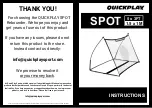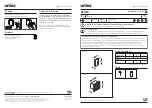
25
The Nitinol rods on the Aravis can all be replaced through small pockets. If you notice that
a Nitinol rod has been damaged or misshapen because of incorrect use, this can be
replaced by MAC PARA or authorised workshops.
Ensure that the lines are not folded tightly. It’s extremely important to avoid any sharp
bending of the lines, especially the main lines. Pay careful attention to the lines to avoid
damaging them. Any over stretching of lines apart from the strain imposed during normal
flight, should be avoided as over stretching is irreversible.
Be careful, not to allow snow, sand or stones to enter inside the canopy’s cells: the weight
can change the angle of attack, or even stall the glider; additionally the sharp edges can
destroy the cloth!
Check main line lengths inclusive risers and quick links after 50 flight hours or after tree or
water landings. Lines can stretch or shrink.
Never drag the wing over rough ground! This will damage the cloth on the wear points.
When preparing the wing on a take-off with rough ground, don’t pull the wing over it (i.e. by
pulling the brakes). Please try to pack the wing on soft ground.
Uncontrolled strong wind take-offs or landings can result in the leading edge of the canopy
hitting the ground at high speed which may cause rips in the profile and damage the rib
material. Any repairs on paragliders are very expensive.
Clean the paraglider with fresh water after contact with salt water. Salt water crystal can
reduce line strength, even after rinsing in fresh water. Replace lines immediately after
contact with salt water. Also check canopy material after water landings, as waves can
place uneven forces and cause cloth to distort in specific areas. Always remove gliders
from the water by holding only the trailing edge.
Clean the paraglider with water and a soft sponge. Do not use any chemicals or spirits for
cleaning, as these can permanently damage the cloth
.
Do not pack your glider too tightly after use and, even though it is very comfortable, never
sit on the backpack with the glider inside.
Maintenance
Identification label
MAC PARA gliders have an identification label on central rib. It is helpful to provide the
type designation of the paraglider if you are contacting your MAC PARA dealer with any
queries or ordering replacement parts or accessories, to ensure accurate identification.
Regular inspections
Risers and quick-links, lines and fabric must be inspected regularly for damage, abrasion
and correct operation.
Tissue and Canopy check
A full visual check should be carried out: All the components of the wing (stitching, ribs,
diagonals, lines, tabs, etc.) should be checked for signs of deterioration.
Summary of Contents for ARAVIS Series
Page 1: ...1...
Page 31: ...31 LINE PLAN ARAVIS...
Page 34: ...34 CHECKS Name Company Date Signature Stamp...
Page 36: ...36...












































